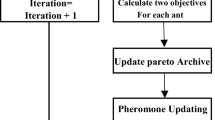Abstract
The community structure, owing to its significant status, is of extraordinary significance in comprehending and detecting inherent functions in real networks. However, the community structures are always hard to be identified, and whether the existing algorithms are based on optimization or heuristics, the robustness and accuracy should be improved. The physarum (i.e., slime molds with multi heads) has proved its ability to produce foraging networks. Therefore, we adopt physarum so that the optimization-based community detection algorithms can work more efficiently. Specifically, a physarum-based network model (pnm), which is capable of identifying inter-edges of the community in a network, is used to optimize the prior knowledge of existing evolutional algorithms (i.e., genetic algorithm, particle swarm optimization algorithm and ant colony algorithm). the optimized algorithms have been compared with some advanced methods in synthetic and real networks. experimental results have verified the effectiveness of the proposed method.
Graphic abstract














Similar content being viewed by others
Data Availability Statement
This manuscript has no associated data or the data will not be deposited. [Authors’ comment: All network used in Sec. 4.1 are public datasets and cited in terms of footnote in Page 6].
References
C. Gao, J.M. Liu, IEEE Trans. Syst. Man Cybern. -Syst. 47, 171 (2017)
S.D. Li, L.Y. Jiang, X.B. Wu et al., Appl. Math. Comput. 401, 126012 (2021)
P. Zhu, X. Dai, X. Li et al., Europhys. Lett. 126, 48001 (2019)
B. Luzar, Z. Levnajic, J. Povh et al., PLoS One 9, e94429 (2014)
Z. Wang, C.Y. Wang, C. Gao et al., Sci. China-Inf. Sci. 63, 212205 (2020)
C. Gao, Z. Su, J.M. Liu, J. Kurths, Commun. ACM 62, 61–67 (2019)
M. Girvan, M.E.J. Newman, Proc. Natl. Acad. Sci. USA 99, 7821 (2002)
H.J. Li, L. Wang, Y. Zhang et al., New J. Phys. 22, 063035 (2020)
M.G. Gong, Q. Cai, X. Chen et al., IEEE Trans. Evol. Comput. 18, 82 (2014)
Z. Wang, C.Y. Wang, X.H. Li et al., IEEE Trans. Knowl. Data Eng. (2020). https://doi.org/10.1109/TKDE.2020.2997043
C.Y. Wang, F. Zhang, Y. Deng et al., Chaos Soliton Fract 138, 109886 (2020)
X.H. Li, C. Gao, P.R. Yang, in 10th International Conference on Natural Computation (ICNC), Xiamen, 2014, p. 486. https://ieeexplore.ieee.org/document/6975883
Q. Cai, M.G. Gong, L.J. Ma et al., Inf. Sci. 316, 503 (2015)
C. Mu, J. Zhang, L. Jiao, in Proceedings of IEEE Congress on Evolutionary Computation, Beijing, 2014, p. 700. https://ieeexplore.ieee.org/document/6900411
P.S. Shelokar, V.K. Jayaraman, B.D. Kulkarni, Anal. Chim. Acta 509, 187 (2004)
C. Gao, M.X. Liang, X.H. Li et al., IEEE/ACM Trans. Comput. Biol. Bioinf. 15, 1916 (2018)
A. Tero, S. Takagi, T. Saigusa et al., Science 327, 439 (2010)
C. Gao, C. Liu, D. Schenz et al., Phys. Life Rev. 29, 1 (2019)
C. Gao, S. Chen, X.H. Li et al., Appl. Soft. Comput. 61, 239 (2017)
Y.T. Lu, M.X. Liang, C. Gao et al., In International Conference on Natural Computation (Fuzzy Systems and Knowledge Discovery, Changsha, 2016), p. 673
M. Tasgin, A. Herdagdelen, H. Bingol, Comput. Res. Repos. 2005, 1067 (2007)
D. Jin, D.X. He, D.Y. Liu, et al., in 22nd International Conference on Tools with Artificial Intelligence, Arras, 2010, p. 105. https://ieeexplore.ieee.org/document/5670026/
M. Dorigo, M. Birattari, T. Stutzle, I.E.E.E. Comput, Intell. Mag. 1, 28 (2006)
D. Jin, D.Y. Liu, B. Yang et al., Adv. Complex Syst. 14, 795 (2011)
X.H. Li, Z.X. Wang, T.Y. Lu et al., J. Bionic Eng. 6, 77 (2009)
A. Tero, R. Kobayashi, T. Nakagaki, J. Teor. Biol. 244, 553 (2007)
C. Gao, Y. Fan, S.H. Jiang et al., IEEE Trans. Intell. Transp. Syst. (2021). https://doi.org/10.1109/TITS.2021.3058185
M.X. Liang, C. Gao, Z.L. Zhang, Nat. Comput. 16, 85 (2017)
F. Wu, B.A. Huberman, Eur. Phys. J. B 38, 331 (2004)
A. Lancichinetti, S. Fortunato, F. Radicchi, Phys. Rev. E 78, 046110 (2008)
A. Clauset, C.R. Shalizi, M.E.J. Newman, SIAM Rev. 51, 661 (2009)
H.H. Chang, Z.R. Feng, Z.G. Ren, in IEEE Congress on Evolutionary Computation, Cancun, 2013, p. 3072. https://ieeexplore.ieee.org/document/6557944
C. Pizzuti, in Proceedings of International Conference on Parallel Problem Solving from Nature, Dortmund, 2008, p. 1081. https://doi.org/10.1007/978-3-540-87700-4_107
D. Jin, B. Yang, J. Liu et al., J. Softw. 23, 451 (2012)
M.E.J. Newman, Phys. Rev. E 69, 066133 (2004)
U.N. Raghavan, R. Albert, S. Kumara, Phys. Rev. E 76, 036106 (2007)
V. Satuluri, S. Parthasarath, in Proceedings of the International Conference on Knowledge Discovery and Data Mining, Paris, 2009, p. 737
J.J. Chen, S.P. Gao, Z. Su et al., In Proceedings of the International Conference on Natural Computation, Fuzzy Systems and Knowledge Discovery, Kunming, 2019, p. 141. https://doi.org/10.1007/978-3-030-32456-8_15
A. Grover, J. Leskovec, in Proceedings of the 22nd ACM SIGKDD International Conference on Knowledge Discovery and Data Mining, San Francisco, 2016, p. 855. https://doi.org/10.1145/2939672.2939754
B. Perozzi, R. Al-Rfou, S. Skiena, in Proceedings of the 20th ACM SIGKDD International Conference on Knowledge Discovery and Data Mining, New York, 2014, p. 701. https://doi.org/10.1145/2623330.2623732
X. Wang, P. Cui, J. Wang, et al., in Proceedings of the 31st AAAI Conference on Artificial Intelligence, San Francisco, 2017, p. 203. https://doi.org/10.5555/3298239.3298270
B. Perozzi, V. Kulkarni, H. Chen, et al., in Proceedings of the IEEE/ACM International Conference on Advances in Social Networks Analysis and Mining, Sydney, 2017, p. 258. https://doi.org/10.1145/3110025.3110086
B. Rozemberczki, R. Davies, R. Sarkar, et al., in Proceedings of the IEEE/ACM International Conference on Advances in Social Networks Analysis and Mining, Vancouver, 2019, p. 65. https://doi.org/10.1145/3341161.3342890
Acknowledgements
This work was supported by the National Key R&D Program of China (No. 2020AAA0107700), National Natural Science Foundation of China (Nos. 61976181, 11931015, U1803263), Fok Ying-Tong Education Foundation, China (No. 171105), Key Technology Research and Development Program of Science and Technology Scientific and Technological Innovation Team of Shaanxi Province (No. 2020TD-013), the Science and Technology Foundation of Guizhou (No. QKHJC20181083) and the Science and Technology Support Program of Guizhou (No. QKHZC2021YB531).
Author information
Authors and Affiliations
Corresponding author
Rights and permissions
About this article
Cite this article
Li, X., Gao, C., Wang, S. et al. A new nature-inspired optimization for community discovery in complex networks. Eur. Phys. J. B 94, 137 (2021). https://doi.org/10.1140/epjb/s10051-021-00122-x
Received:
Accepted:
Published:
DOI: https://doi.org/10.1140/epjb/s10051-021-00122-x




